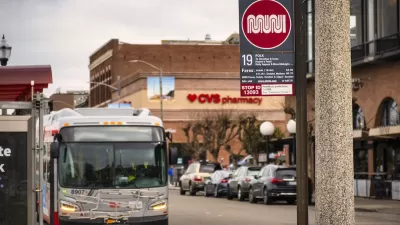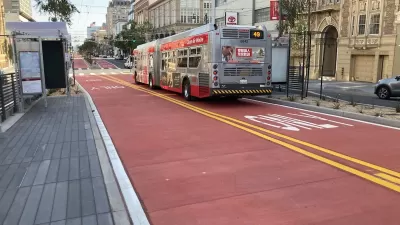The SFMTA is considering a "high-access network" that would let people reach more destinations and increase frequency on some Muni lines.

As part of Jarrett Walker + Associates' work with the San Francisco Municipal Transportation Agency (SFMTA) on its post-pandemic bus service, Jarrett Walker asks, "[w]hen a transit agency comes back from the COVID-19 crisis, should it aim to put service back the way it was, or try to put back something better?"
While Muni has historically served workers commuting into downtown San Francisco, "the pandemic accelerated ongoing trends that have shifted travel patterns away from a single focus on downtown and towards many locations across the city." This summer, SFMTA will present three options to the public to collect feedback and "help the SFMTA Board determine the pattern of Muni service to be implemented in early 2022." The options are:
- Return the Familiar Network
- Build a High-Access Network
- Develop a Hybrid Network, balancing the best features of the first two.
"The High-Access approach would shift some patterns of service to expand people’s ability to get to more destinations sooner," shifting the focus to potentially needed trips that don't exist yet. Because "[b]etter access can mean more opportunities in your life," Walker writes, "[a] high-access network tries to give people as many options as possible."
Regardless of public feedback, "the SFMTA faces severe resource constraints" that will make it difficult to restore pre-pandemic service levels. "It still faces a labor shortage and has lost much of its income from fares and parking revenues, not to mention the structural deficit that existed even before the pandemic." To Walker, "it makes sense to offer only a level of Muni service that the SFMTA is sure they can sustain, at least until they find new resources to replace funds that have eroded over the last decade and fallen dramatically during the COVID-19 pandemic."
FULL STORY: San Francisco: Go Forward by Going Back?

Planetizen Federal Action Tracker
A weekly monitor of how Trump’s orders and actions are impacting planners and planning in America.

San Francisco's School District Spent $105M To Build Affordable Housing for Teachers — And That's Just the Beginning
SFUSD joins a growing list of school districts using their land holdings to address housing affordability challenges faced by their own employees.

The Tiny, Adorable $7,000 Car Turning Japan Onto EVs
The single seat Mibot charges from a regular plug as quickly as an iPad, and is about half the price of an average EV.

Seattle's Plan for Adopting Driverless Cars
Equity, safety, accessibility and affordability are front of mind as the city prepares for robotaxis and other autonomous vehicles.

As Trump Phases Out FEMA, Is It Time to Flee the Floodplains?
With less federal funding available for disaster relief efforts, the need to relocate at-risk communities is more urgent than ever.

With Protected Lanes, 460% More People Commute by Bike
For those needing more ammo, more data proving what we already knew is here.
Urban Design for Planners 1: Software Tools
This six-course series explores essential urban design concepts using open source software and equips planners with the tools they need to participate fully in the urban design process.
Planning for Universal Design
Learn the tools for implementing Universal Design in planning regulations.
Smith Gee Studio
City of Charlotte
City of Camden Redevelopment Agency
City of Astoria
Transportation Research & Education Center (TREC) at Portland State University
US High Speed Rail Association
City of Camden Redevelopment Agency
Municipality of Princeton (NJ)





























